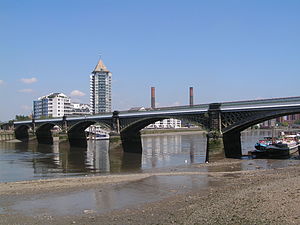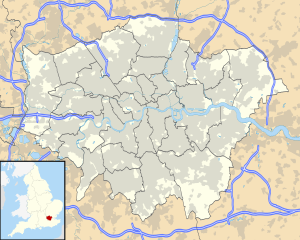Battersea Railway Bridge
Coordinates: 51 ° 28 ′ 23 " N , 0 ° 10 ′ 46" W.
| Battersea Railway Bridge | ||
|---|---|---|
| Official name | Cremorne Bridge | |
| use | Railway bridge | |
| Convicted | West London Line | |
| Subjugated | Thames | |
| place | London | |
| construction | Arch bridge with wrought iron structure | |
| overall length | 220 m (with preliminary bridges 387 m) | |
| Number of openings | 5 (with landing bridges 15) | |
| building-costs | £ 104,000 | |
| opening | May 1863 | |
| location | ||
|
|
||
The Battersea Railway Bridge (officially Cremorne Bridge , originally Battersea New Bridge ) is a railway bridge over the River Thames in London . It is used by the double-track West London Line , which circumnavigates the city center to the west, connecting Clapham Junction and Willesden Junction .
The bridge is 220 meters long, together with the viaducts on both banks of the river 387 meters. The main bridge consists of five wrought iron arches that rest on masonry pillars. One of the viaduct arches on the north side was broken to allow the footpath along the river through the bridge.
The chief engineer of the railway company, William Baker, was responsible for the construction. The construction cost was £ 104,000. The bridge was put into service in May 1863 by the London and North Western Railway . At the beginning, the bridge was only used by freight trains; passenger trains have only been running over the bridge since 1904. In 1969 and 1992 the bridge was reinforced. Today it is seen as the bottleneck in rail traffic, as the maximum speed of trains is limited to 25 km / h.
Immediately next to the Battersea Railway Bridge, the construction of a pedestrian bridge called Jubilee Bridge is planned.
Web links
- Battersea Railway Bridge. In: Structurae
- William Humber: A Record of the Progress of Modern Engineering: Comprising Civil, Mechanical, Marine, Hydraulic, Railway, Bridge, and Other Engineering Works; with essays and reviews . Lockwood & Company, 1864, p. 38 ff., plates p. 140 ff . ( limited preview in Google Book search).
Individual evidence
- ↑ a b c d William Humber p. 39.
- ^ Battersea Railway Bridge. In: Where Thames Smooth Waters Glide. Retrieved May 26, 2013 .
- ^ New Bridge At Battersea One Step Closer. In: Londonist. November 19, 2012, accessed May 26, 2013 .
|
upstream Wandsworth Bridge |
River crossings of the Thames |
downstream Battersea Bridge |

